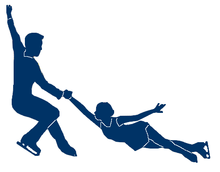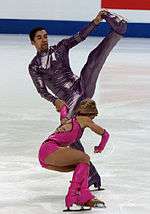Death spiral (figure skating)
| Figure skating element | |
|---|---|
 | |
| Element name: | Death spiral |
| Scoring abbreviation: | Ds |
| Disciplines: | Pair skating |
Death spiral is a required element of pair skating performed with the man in a pivot position, one toe anchored in the ice. Holding his hand, the woman circles her partner on a deep edge with her body almost parallel to the ice. In 2011, the ISU introduced a requirement that the woman's head must at some time reach the level of her skating knee in order to receive a value.[1] The man should be in a full pivot position, and the death spiral must be held for a minimum amount of rotation, depending on the level.
Variations





.jpg)
Death spirals can be performed in all four variants of inside/outside and forward/backward edges. The outside edge death spirals are considered more difficult than the inside edge variants. The forward outside death spiral is seen as the hardest of all.
Pairs may increase their score by incorporating a difficult entry or exit and/or holding the position during the death spiral. These may be one of the spiral positions, the Biellmann, shoot-the-duck, or other position. Pairs may also change the hand hold during the death spiral.
History
The backward outside death spiral was invented in 1928 by Charlotte Oelschlagel and Curt Neumann,[2] although it was first performed with the skaters holding both hands and the woman not fully lowered toward the ice. The current one-handed version was developed in the 1940s by the Canadian pair Suzanne Morrow and Wallace Diestelmeyer. The other death spiral variants were invented by Ludmila Belousova and Oleg Protopopov in the 1960s.[3] They assigned the following names to them: Cosmic spiral (backward inside), Life spiral (forward inside), and Love spiral (forward outside).
ISU Judging System
Under the ISU Judging System, the death spiral is abbreviated as "Ds" in the protocol, and preceded by a capital F or B indicating the direction and lower-case i or o for the edge; the level appears as a digit following the four letters.[4] Thus the abbreviations are:
| Edge | Abbreviation |
|---|---|
| Forward Inside | FiDs |
| Forward Outside | FoDs |
| Backward Inside | BiDs |
| Backward Outside | BoDs |
A level three backward inside death spiral would be written as BiDs3.
For the 2007-2008 season, the back inside death spiral was the required death spiral for the senior pairs short program. For the 2008-2009 season, the required death spiral was the forward inside.[5]
References
- ↑ "2012/2013 Records of Clarifications from Sports Directorate and Technical Committee: PAIR SKATING Death Spirals". International Skating Union. 1 October 2012. Archived from the original (PDF) on 7 January 2013.
- ↑ Kelli Lawrence, Skating on Air: The Broadcast History of an Olympic Marquee Sport, p. 8
- ↑ Lyudmila Belousova & Oleg Protopopov, archived from the original on 7 January 2010
- ↑ "Communication No. 1445" (PDF). International Skating Union. Archived from the original (PDF) on 7 July 2007.
- ↑ "Special Regulations & Technical Rules: Single & Pair Skating and Ice Dance 2012" (PDF). International Skating Union. June 2012. Archived from the original (PDF) on 29 October 2013.
| Wikimedia Commons has media related to Death spirals. |